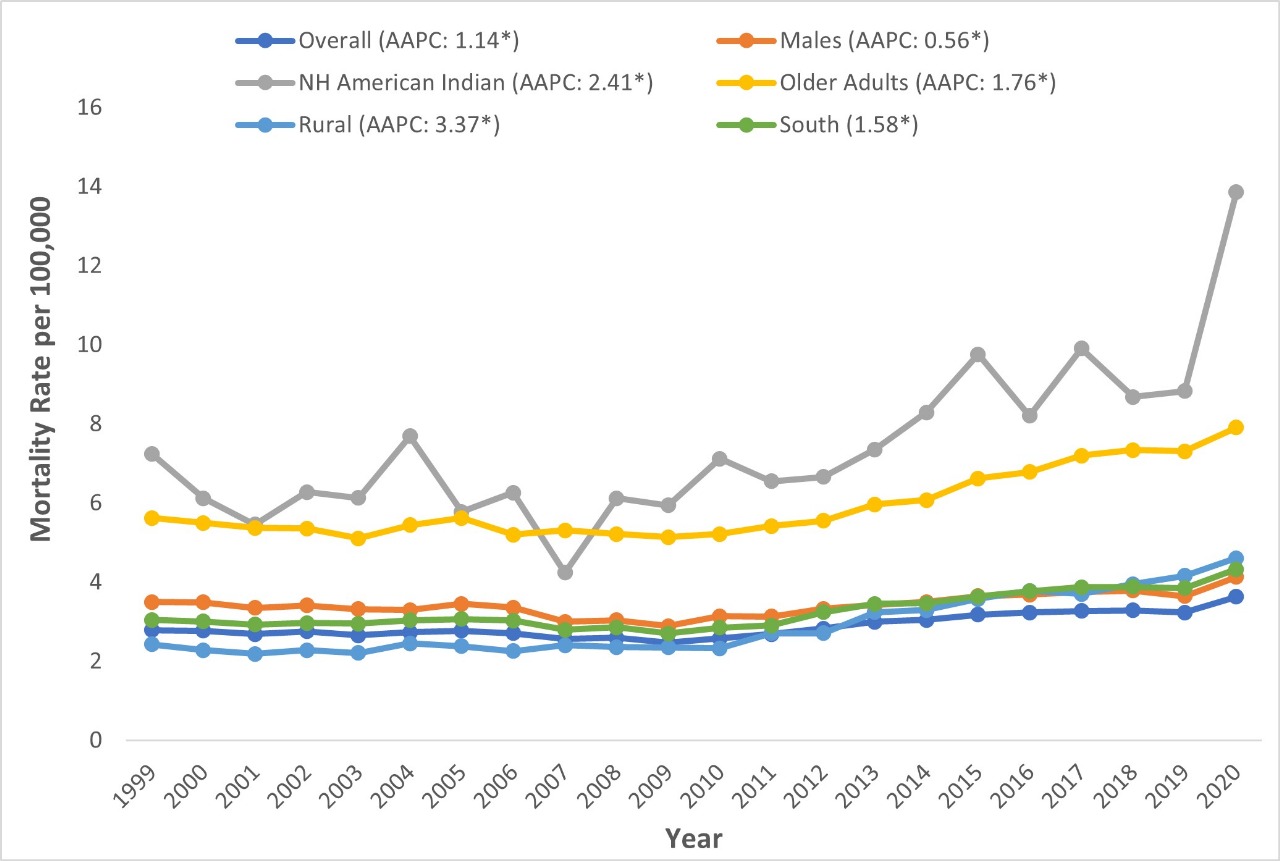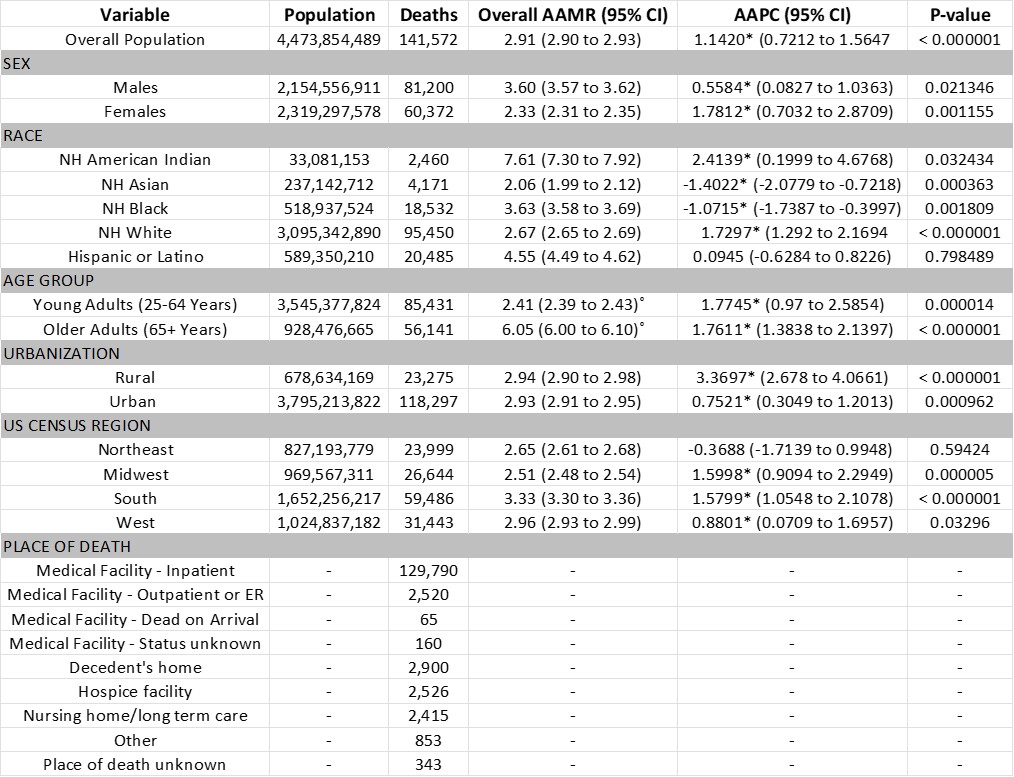Sunday Poster Session
Category: Liver
P1662 - Trends and Disparities in Chronic Liver Disease and Septicemia Related Mortality in the United States From 1999 to 2020: A Retrospective Analysis
Sunday, October 26, 2025
3:30 PM - 7:00 PM PDT
Location: Exhibit Hall

Faryal Altaf, MD (she/her/hers)
BronxCare Health System
Bronx, NY
Presenting Author(s)
Ahmed Faizan, MBBS1, Haseeb Ali, MD2, Asad Ur Rahman, MD3, Raul Reina, MD4, Abeer Qasim, MD5, Faryal Altaf, MD5
1Allama Iqbal Medical College, Lahore, Punjab, Pakistan; 2Services Hospital Lahore, Albany, NY; 3Cleveland Clinic Florida, Weston, FL; 4BronxCare health system, Bronx, NY; 5BronxCare Health System, Bronx, NY
Introduction: Chronic liver disease (CLD) is one of the most common diseases worldwide. In 2018, an estimated 4.5 million people had CLD in the US, and it was the 12th leading cause of death in 2020. Patients with CLD are at an increased risk of developing infections and septicemia. This study aims to analyze the trends of septicemia-related mortality in patients with CLD stratified by year, age, gender, race, and geographical region.
Methods: The CDC WONDER mortality database was queried for data from death certificates of adults aged ≥25 years. We calculated crude mortality rates (CMRs) and age-adjusted mortality rates (AAMRs) per 100,000 population. The temporal variations in the data were outlined by estimating the annual percent change (APC) and the average annual percent change (AAPC) using Joinpoint Regression.
Results: A total of 141,572 deaths were reported in patients of CLD and septicemia between 1999 and 2020, demonstrating an overall rising trend (AAPC: 1.14). Although males (AAMR: 3.60) had a higher overall AAMR than females (2.33), there was a greater rise in mortality in females (AAPC: 1.78) than males (AAPC: 0.56). Non-Hispanic (NH) American Indians had the highest AAMR (7.61), while NH Whites (2.67) and NH Asians (2.06) had the least. Older adults (65+) had significantly higher CMRs than young adults (25-64) throughout the study period (6.05 vs 2.41). Both rural (2.94) and urban (2.93) areas had similar AAMRs, but rural areas experienced a much higher increase between 2009 and 2020 (APC: 6.17). The South had the highest mortality (3.33), followed by the West (2.96), the Northeast (2.65) and the Midwest (2.51). The states with the highest AAMR were the District of Columbia (5.42) and Texas (4.90), while the states with the lowest AAMR were Vermont (1.76) and Nebraska (1.66).
Discussion: The trend of septicemia-related mortality in CLD patients has been on the rise in the last 2 decades, with the greatest burden being experienced by males, NH American Indians, inhabitants of the South, and those over the age of 65. However, the greatest increase in mortality during the study was shown by females and rural populations, emphasizing the importance of healthcare delivery in medically underserved areas. The data suggests that septicemia is an important cause of mortality in CLD patients and targeted measures must be implemented to lower the death rate among high-risk groups.

Figure: Trends in Chronic Liver Disease and Septicemia Related Mortality in the High-risk Populations in the United States from 1999 to 2020

Figure: Demographic Characteristics of Chronic Liver Disease and Septicemia Related Deaths in the United States from 1999 to 2020
Disclosures:
Ahmed Faizan indicated no relevant financial relationships.
Haseeb Ali indicated no relevant financial relationships.
Asad Ur Rahman: Abbvie Inc – Speakers Bureau.
Raul Reina indicated no relevant financial relationships.
Abeer Qasim indicated no relevant financial relationships.
Faryal Altaf indicated no relevant financial relationships.
Ahmed Faizan, MBBS1, Haseeb Ali, MD2, Asad Ur Rahman, MD3, Raul Reina, MD4, Abeer Qasim, MD5, Faryal Altaf, MD5. P1662 - Trends and Disparities in Chronic Liver Disease and Septicemia Related Mortality in the United States From 1999 to 2020: A Retrospective Analysis, ACG 2025 Annual Scientific Meeting Abstracts. Phoenix, AZ: American College of Gastroenterology.
1Allama Iqbal Medical College, Lahore, Punjab, Pakistan; 2Services Hospital Lahore, Albany, NY; 3Cleveland Clinic Florida, Weston, FL; 4BronxCare health system, Bronx, NY; 5BronxCare Health System, Bronx, NY
Introduction: Chronic liver disease (CLD) is one of the most common diseases worldwide. In 2018, an estimated 4.5 million people had CLD in the US, and it was the 12th leading cause of death in 2020. Patients with CLD are at an increased risk of developing infections and septicemia. This study aims to analyze the trends of septicemia-related mortality in patients with CLD stratified by year, age, gender, race, and geographical region.
Methods: The CDC WONDER mortality database was queried for data from death certificates of adults aged ≥25 years. We calculated crude mortality rates (CMRs) and age-adjusted mortality rates (AAMRs) per 100,000 population. The temporal variations in the data were outlined by estimating the annual percent change (APC) and the average annual percent change (AAPC) using Joinpoint Regression.
Results: A total of 141,572 deaths were reported in patients of CLD and septicemia between 1999 and 2020, demonstrating an overall rising trend (AAPC: 1.14). Although males (AAMR: 3.60) had a higher overall AAMR than females (2.33), there was a greater rise in mortality in females (AAPC: 1.78) than males (AAPC: 0.56). Non-Hispanic (NH) American Indians had the highest AAMR (7.61), while NH Whites (2.67) and NH Asians (2.06) had the least. Older adults (65+) had significantly higher CMRs than young adults (25-64) throughout the study period (6.05 vs 2.41). Both rural (2.94) and urban (2.93) areas had similar AAMRs, but rural areas experienced a much higher increase between 2009 and 2020 (APC: 6.17). The South had the highest mortality (3.33), followed by the West (2.96), the Northeast (2.65) and the Midwest (2.51). The states with the highest AAMR were the District of Columbia (5.42) and Texas (4.90), while the states with the lowest AAMR were Vermont (1.76) and Nebraska (1.66).
Discussion: The trend of septicemia-related mortality in CLD patients has been on the rise in the last 2 decades, with the greatest burden being experienced by males, NH American Indians, inhabitants of the South, and those over the age of 65. However, the greatest increase in mortality during the study was shown by females and rural populations, emphasizing the importance of healthcare delivery in medically underserved areas. The data suggests that septicemia is an important cause of mortality in CLD patients and targeted measures must be implemented to lower the death rate among high-risk groups.

Figure: Trends in Chronic Liver Disease and Septicemia Related Mortality in the High-risk Populations in the United States from 1999 to 2020

Figure: Demographic Characteristics of Chronic Liver Disease and Septicemia Related Deaths in the United States from 1999 to 2020
Disclosures:
Ahmed Faizan indicated no relevant financial relationships.
Haseeb Ali indicated no relevant financial relationships.
Asad Ur Rahman: Abbvie Inc – Speakers Bureau.
Raul Reina indicated no relevant financial relationships.
Abeer Qasim indicated no relevant financial relationships.
Faryal Altaf indicated no relevant financial relationships.
Ahmed Faizan, MBBS1, Haseeb Ali, MD2, Asad Ur Rahman, MD3, Raul Reina, MD4, Abeer Qasim, MD5, Faryal Altaf, MD5. P1662 - Trends and Disparities in Chronic Liver Disease and Septicemia Related Mortality in the United States From 1999 to 2020: A Retrospective Analysis, ACG 2025 Annual Scientific Meeting Abstracts. Phoenix, AZ: American College of Gastroenterology.
